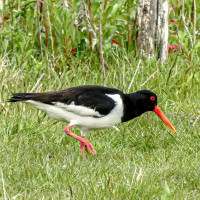Description
The northern part of the peninsula of Hindsholm consists of small islands, islets and crooked spits. There are a few copses and wet and dry meadows. Fyns Hoved itself has attractive scenery. The coast is stony with steep moraine cliffs, whilst inland the landscape is hilly with small fields divided by rows of stone walls. The long spit called Tornen, which is a bird reserve, curves round the shallow lagoon of Fællesstrand. South of the lagoon is the Jøvet, an outlook point with a view southwards towards Lillestrand with the islands of Mejlø, Bogø and the Langehoved peninsula.
Crna njorka nest in the cliffs at Lillestrand 3km to the south and can be seen out at sea off the coast of Fyns Hoved. Breeding birds at the reserves of Tornen and Lillestrand include Šarena utva, Gavka, Ostrigar and Žalar blatarić. Some years Mala čigra breeds here.
Early in the morning at the end of April or May the thickets around Fyns Hoved can be swarming with passerines. The best chance of experiencing this is after misty nights with warm winds from the east. The spring migration can best be seen from Horseklint on the eastern side of Fællesstrand or from Baesbanke, which is the highest point on Fyns Hoved itself (25m). Both land and sea migration can be watched from here. Many species of passerine fly past. Early in spring, the first Poljska ševa appear, followed later on by finches, pigeons and crows. Later still, wagtails, pipits, hirundines, starlings and tits can be seen. The greater part of the raptors seen here are Mišar, which begin migrating in February together with a few Riđa lunja. In March/April, Eja močvarica, Vetruška, Kobac and now and then Ribar can be spotted. Over the sea, there are movements of large numbers of divers, cormorants and ducks, especially diving ducks, the commonest species being Gavka, Baršunasti turpan and Crni turpan. Also Riđovrati gnjurac and Srednji ronac are often seen.
Fællesstrand is an important staging area for ducks and waders, that forage in the shallow waters. The commonest birds seen here are Šarena utva, Zviždara, Crvenonogi sprudnik, Crnotrba sprutka, Velika carska šljuka, Mala carska šljuka and Veliki vranac.The area also attracts many gulls, Dugokljuna čigra and Arktička čigra. In the winter months, many seabirds can be seen on the sea around the peninsula. These include diving ducks, auks, divers and skuas. Snežna strnadica, Morska trepteljka and Morska sprutka can now and then be seen on the coast.
Details
Access
Fyns Hoved can be reached from route 315 which leads north from Kerteminde. The road continues to Korshavn, where one can park. From here, one can walk out to the tip of the peninsula or follow a path along the meadows on the south side of Fællesstrand. In this direction one comes to Horseklint, and can continue out to the Tornen spit. However, access to Tornen is forbidden during the breeding season from 1st April until 15th July. It is also possible to continue by car from Korshavn on a dirt track to a car park closer to the tip of the peninsula. From here, one must continue on foot. There are toilets at the car park at Korshavn. From here, one can find a path leading up to the outlook point on Jøvet.
,_Etangs_de_Stavelot,_Belgien_(38631119665) Frank Vassen.jpg)
,_Etangs_de_Stavelot,_Belgien_(38631119665) Frank Vassen.jpg)
